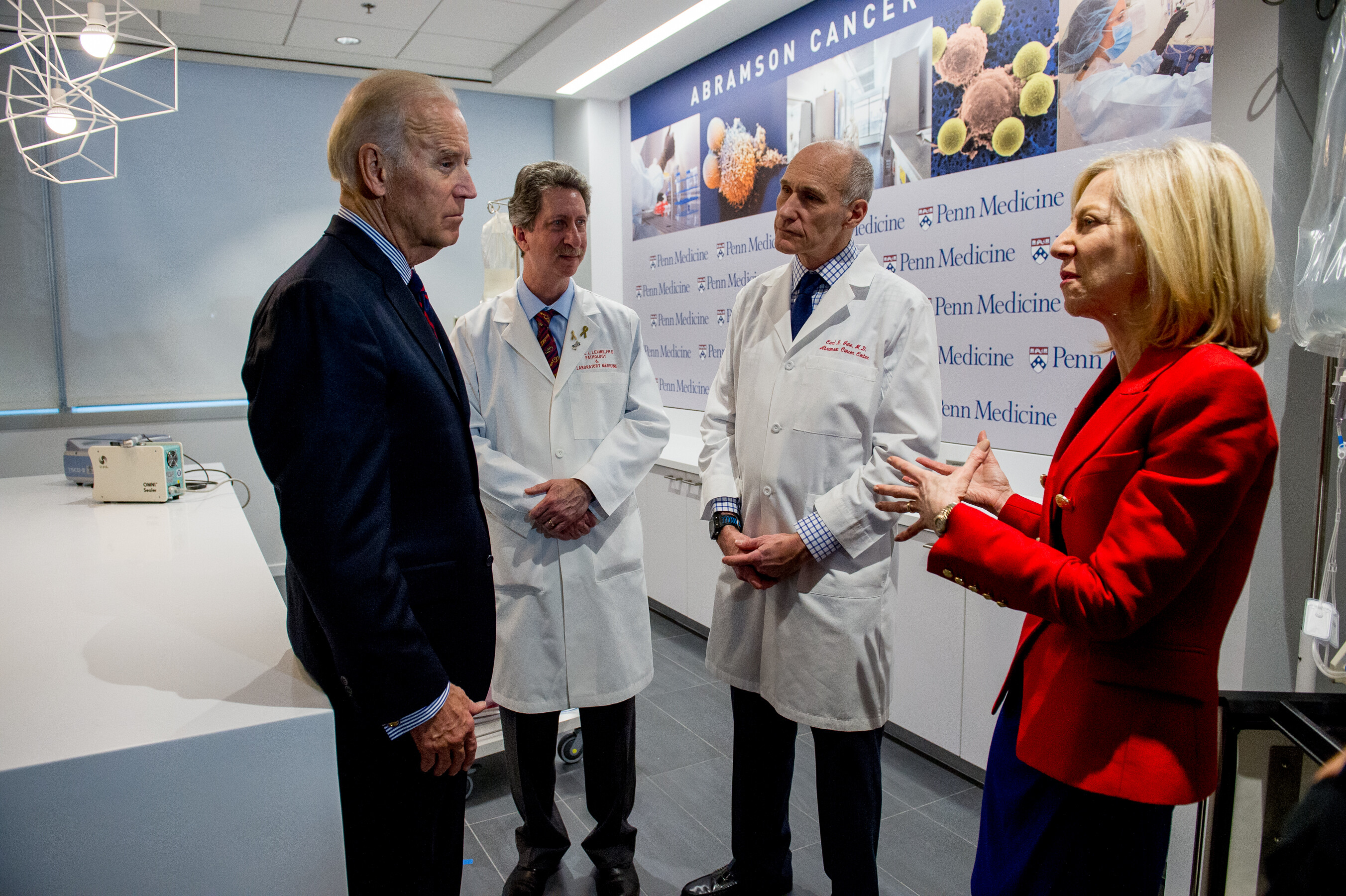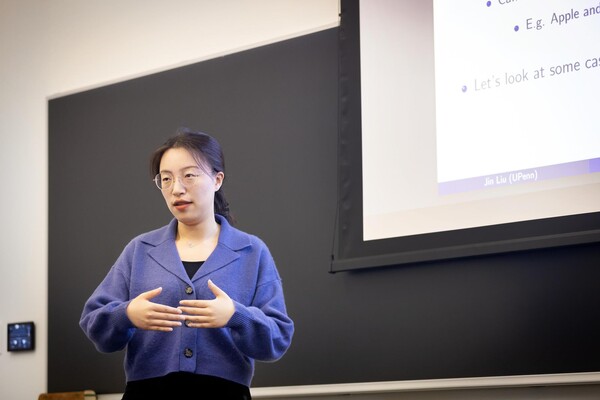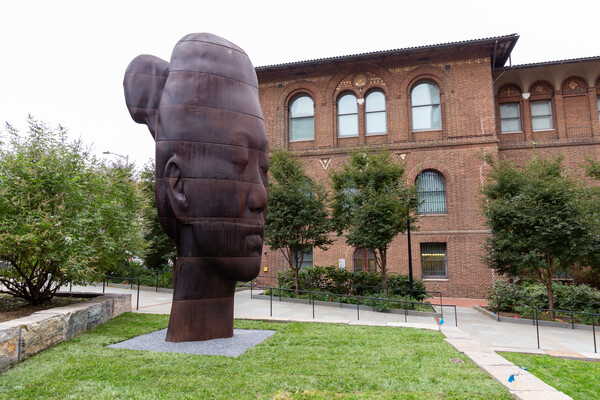
(From left) Doctoral student Hannah Yamagata, research assistant professor Kushol Gupta, and postdoctoral fellow Marshall Padilla holding 3D-printed models of nanoparticles.
(Image: Bella Ciervo)

Since he took the reins of the Abramson Cancer Center in July 2017, there hasn’t been one day where Robert H. Vonderheide hasn’t felt a thrill.
“This place is on fire,” he says. “Drugs are being approved, there are new discoveries, we are excited by all the Nature, Science, and Cell papers. People are flocking here to find out what’s going on.”
Vonderheide, a Penn Medicine professor and physician scientist, with his own 14-person lab in the Smilow Center for Translational Research, was drawn to the University in 2001 for its researchers’ early work in immunology. Throughout the years, Vonderheide has not only helped make discoveries in the field, he’s also directed clinical trials for patients, and, of course, analyzed the findings from those trials.
“We go from the laboratory to the clinic and then back to the lab,” he says. “It’s a united effort, not a split effort. That’s translational research—a signature feature of the Abramson Cancer Center.”
The Cancer Center, formally established in 1973 and aptly renamed in 2002 upon significant support from the Leonard and Madlyn Abramson family, has evolved throughout the years into divisions that seek to prevent, diagnose, and cure cancer through the development of new knowledge, diagnostic tests, and therapies.
Peering out his Perelman Center for Advanced Medicine window, overlooking the ever-changing Philadelphia skyline, Vonderheide can’t help but reflect on the past year, which witnessed breakthrough after breakthrough. Based on studies directed by the Abramson Cancer Center and Penn Medicine faculty, the world has seen four FDA approvals for three cancer drugs: Kymriah, Lynparza, and Azedra.
“We are employing the entire University to make advances for cancer care and cancer research,” he says. “That’s going to continue to be our secret of success going forward.”
Vonderheide took time out of his busy schedule to chat in-depth with Penn Today about his background, what’s kept him at Penn all these years, why leading the Abramson Cancer Center is so exciting, the Center’s role in the new Patient Pavilion, and much, much more.
After graduating from Notre Dame, I went to Oxford University on a Rhodes Scholarship to study immunology. I completed a doctorate in basic science and decided that the greatest way to make that come alive was to apply it to medicine, so I went to Harvard Medical School. I did my residency at Massachusetts General and my clinical oncology fellowship at the Dana-Farber in Boston. It was about 2001, and my wife Susan Domchek and I looked for an up-and-coming place to launch careers in the areas of immunology and genetics. For me, I think it’s fair to say that many years ago, there was still quite a bit of doubt in immunology. I was fortunate to find real confidence in immunology at Penn, which by that time had already recruited this young guy named Carl June and a number of other immunotherapists. It was an ideal place to come. It was my first faculty position and I never left. And, Susan is now executive director of Penn’s Basser Center for BRCA.
The Abramson Cancer Center is a very large, multifaceted enterprise to deliver cancer care and to find better ways to treat and prevent cancer. We are not a freestanding cancer center; we are woven into the fabric of the University. We have several hundred members who belong to 42 different departments and seven different schools. We are supported not only by the institution but also by the National Cancer Institute. We are a comprehensive cancer center, one of only 49 in the U.S., which means we do everything from A to Z. There are two main responsibilities: to oversee and drive the cancer research enterprise here at the University of Pennsylvania and the Perelman School of Medicine, but also to direct the delivery of care through a multidisciplinary interprofessional health system that includes six adult hospitals and, of course, a very strong relationship with the Children’s Hospital of Philadelphia.
It’s been unbelievably fantastic. The Abramson Cancer Center is on fire in so many ways, with new discoveries, new therapies, improvements in patient care, impact on our population, impact on policy. It is comprised of the most amazing and dedicated physicians, staff, nurses, scientists, who all work together. Our Deputy Director Kate Nathanson and I often remark to each other that collaboration is fundamental to how we work. And it’s been a very exciting year with four FDA approvals, all based on studies that were directed by faculty at the Abramson Cancer Center and Penn Medicine.
We have celebrated, as you know, with “flash mobs.” These FDA approvals extend beyond immunology. The most recent one had to do with a new radiopharmaceutical, which is uniquely effective on very rare tumors called pheochromocytoma or paraganglioma; it received FDA approval earlier this summer. Radiopharmaceuticals are a cutting-edge way to treat cancer, and we were very proud that this particular effort was for patients who have a rare tumor. All tumors are important to study, and we see a very special part of our mission as taking care of patients with all types of cancer, even the rare ones, independent of whether there’s a business market or other considerations. We are dedicated to the oldest, the youngest, the most common, the rarest. Cancer in all its forms is our enemy.

Because we are a matrix cancer center, Abramson Cancer Center is a vital part of Children’s Hospital of Philadelphia, and Children’s Hospital is a vital part of the Abramson Cancer Center. I just actually came from a meeting with a computational biologist at CHOP. From my point of view, CHOP is the best pediatric oncology center in the country and we have members of our Cancer Center who take care of children with cancer, but we also have researchers—not physicians—who work in laboratories at the Children’s Hospital who are part of our Cancer Center. Many cancer centers don’t have that expertise in pediatric oncology, and we really feel that’s an incredibly special part of what we do.
We see more than 34,000 new patients with cancer a year. They come from near and far. They’re young and old, with common cancers and with rare cancers. Our arms are open, quite literally, to the entire community. And that community is growing, certainly in Philadelphia, and regionally—folks can either come to Center City or go to one of the other hospitals that are part of the Abramson Cancer Center, such as Lancaster General and Chester County hospitals. More and more, particularly around new and advanced care models, such as bone marrow transplant, precision surgery, or CAR T cell infusions, we’re becoming a destination center where people will travel here from all over the country and all over the world to access the kind of care that we deliver. That makes for the most amazing Cancer Center where, in the waiting room, there are patients from Upper Darby, Center City, and Ohio, maybe London, and they’ve all come trusting us with their care, because first and foremost we’ll deliver standard of care in the best possible way and secondly, whenever possible, we want to offer patients something cutting-edge—perhaps a clinical trial, genetic screening, a new type of radiation treatment, or specialized surgery that we are developing and advancing.
We anticipate a large part of the new Pavilion will be devoted to taking care of cancer patients. The Cancer Center is already a huge part of Penn Medicine, a vital and important one that reaches multiple disciplines and multiple professions. We celebrate the fact that a lot of care for patients with cancer has moved to the outpatient facility, which is why we built that first. The Perelman Center for Advanced Medicine is an unsurpassed infrastructure for delivering care. And by the way, so is our Cherry Hill clinic, so is the Barshinger Cancer Institute at Lancaster General, or the clinic at Pennsylvania Hospital. We have brand new buildings at Penn Presbyterian, new renovations at Chester County, and we have a partner in the newest hospital to join Penn Medicine, Princeton Hospital. We have wonderful outpatient facilities where you are greeted at the front door. But there will always be a need for delivering the highest, most advanced care in a hospital that is able to connect with all the other medical disciplines. It’s not a cancer hospital, but there’s a lot of cancer care that will happen in the hospital. We have the advantage of wonderful surgical colleagues, wonderful cardiovascular colleagues, wonderful infectious disease colleagues, and on and on, all of whom we rely on to help us take care of the patient before us who has cancer.
Being part of a general hospital is exactly where we need to be in 2020. We have outlived and outrun the capacity of the current Hospital of the University of Pennsylvania. We’re so excited about the Pavilion. And we plan to configure it to deliver care for cancer patients in the way we can now—and not how we delivered it in 1980. It’s a huge opportunity for us to deliver truly patient-focused care, and will be an amazing inflection point in Penn Medicine.
There are so many things to say. We are devoted to finding basic science discoveries and developing new drugs and getting them FDA approved. We are committed to tumor genetics, inherited genetics, and cancer prevention, and support world-class efforts in smoking cessation and environmental cancer toxicology. We have been an epicenter for the development of immune therapies for cancer, especially engineered T cell therapy. Immunotherapy is changing the way we treat cancer patients, nothing short of a revolution in care. And equally impactful has been innovation around delivering cancer care. I am very grateful to Larry Shulman, our deputy director for clinical services, who overviews the medical aspects of these efforts. There are much more efficient and less toxic ways to give chemotherapy. There are much more efficient ways to set up the operations of the clinic so that patients don’t wait as long. There are new options where if a patient gets sick, they don’t necessarily have to go to the emergency room, they come to the Cancer Center directly to be seen. There are ways that we provide navigation. Once you hear the words, ‘You have cancer,’ you feel the urgency and the confusion. Who do you call? Who do you trust? It’s hard, it’s very complex. We have patient and family services at all our hospitals that more easily guides patients through the system. We are always pushing for higher quality and standards around pharmacy prescriptions, drug-drug interactions, patient safety at home, serious illness conversations.
We started a large program—we’re told the most successful in the country—about advancing a discussion with patients who are seriously ill about end of life issues, and to do that months before the family and the patient have to make decisions, rather than days before. This is having incredible impact. In other examples, we’re figuring out how to make a bladder surgery go even more smoothly, or how to get a patient home sooner after brain surgery. It turns out, this can be methodically studied. We make a change and ask, “Did it work? Yes or no?” If it worked, we’re on to the next innovation. There’s a great deal of science around delivering health care.
Immunotherapy is changing the way we treat cancer patients, nothing short of a revolution in care.
Robert H. Vonderheide, Abramson Cancer Center director
Every day is different, every day is exciting. The discussions from meeting to meeting are different. I’ll go from a lab meeting to listening to an outside speaker to meeting about clinical operations, to giving a budget debrief. But it’s always fun. I’m continually amazed by the talent, the dedication, the selflessness of the people who work here, and how patient-focused they are.
Cancer research and improvements in care is rapidly changing and it’s extremely exciting. Cancer deaths have gone down in this country 1 percent a year for 20 years. We’re winning. We’ve learned how to win, but there’s so much more to do. Too many patients still succumb—600,000 patients in the United States a year—but we’re beginning to get traction on the solutions. I’ve said this before: We’re not declaring victory, we’re declaring hope. If you’re the Cancer Center director and you wake up wondering, ‘What will be discovered today?’ and know that something will be, that’s a pretty exciting job.
We are an ecosystem. We have everything from basic research, clinical care, clinical research, outreach to our community. We have wonderful hospitals, wonderful clinics, we have wonderful physicians and nurses. But we have more than that. We have this amazing School of Medicine, which we are very proud to be part of, with world-class pulmonary care and cutting-edge heart surgery, and advances in neuroscience, and on and on. It doesn’t stop there either. We’re part of this world-class university. We have interactions with Penn Vet, the School of Nursing, Wharton, Annenberg, the School of Engineering. This is really unparalleled, this ecosystem. And underlying all of this is what I call ‘Penn Pride.’ If I am at the Vet School and interact with a researcher there, what we have in common is this Penn Pride. We’re not competing. It’s who we are. I think it’s unique, and it’s really special. We’re an ecosystem where every part is dependent on the other part.

It’s a source of pride. We were so proud to have launched that movement for the country. We’re making progress, we’re on an inflection point, and of course, to have the work we are doing endorsed by the former vice president was a great moment for us. And we’re happy he’s a member of the faculty.
We are super excited to be part of the Power of Penn campaign and we are looking forward to the opportunities that the campaign will afford Penn, Penn Medicine, and Abramson Cancer Center, to take this already stellar endeavor to the next level. We’re ready. Our ideas are powerful and they need to be resourced. We do very well, we have a deep support of the institution, of the federal government, of foundations, and philanthropic partners, but we can do even more. When it comes to philanthropic partners, they provide the kind of resources that allow us to take chances and to do what Vice President Biden challenges us to do, which is to accomplish in five years what would otherwise take 10. We don’t just talk about innovation, we do it. Innovation takes ideas. And ideas are very fragile and if you don’t support them, they fail. So as ideas come up, we need to be able to support them right away. And this is where support from our philanthropic donors means everything. Many of the successes we have been discussing today can be traced back to a meeting between a scientist and a philanthropist where the philanthropist said, ‘That’s a good idea, let’s get started today.’
We will continue to lead in basic science, immunology, clinical care, and cancer prevention. I hope we’re talking even more about prevention and about survivorship, and driving the appreciation of immune health. In fact, with immunology, there are new opportunities in prevention. We have to recognize and celebrate that many more patients are surviving. We need to be there for survivors too and understand what cancer survivorship is all about and continue to improve their lives.
Homepage photo: Peering out his office window, overlooking the ever-changing Philadelphia skyline, Vonderheide reflects on his first year as the Abramson Cancer Center’s director.
Lauren Hertzler
Eric Sucar , Penn Medicine

(From left) Doctoral student Hannah Yamagata, research assistant professor Kushol Gupta, and postdoctoral fellow Marshall Padilla holding 3D-printed models of nanoparticles.
(Image: Bella Ciervo)

Jin Liu, Penn’s newest economics faculty member, specializes in international trade.
nocred

nocred

nocred